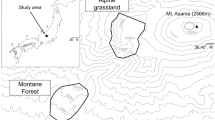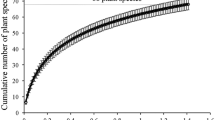Summary
Three sympatric species of Neotoma occur in the southern Great Basin Desert in northern Arizona. Observations and experiments from 1980–1984 focused on diet and den selection to determine to what extent woodrats partition available food and shelter. Analyses included microscopic inspection of feces from live-trapped animals, forage moisture content, and seasonal habitat utilization. Each species of woodrat was found to selectively forage on a different genus of the three evergreens on the study site: N. albigula was the only species to eat appreciable amounts of Yucca, while N. devia, specialized on Ephedra epidermis, and N. stephensi on Juniperus. Observations in the laboratory showed a linear dominance hierarchy where the larger species dominated smaller ones, i.e., N. albigula>N. stephensi>N. devia. To determine if such a hierarchy existed in the field, the behaviorally dominant species (N. albigula and N. stephensi) were continually removed (from a 25 ha experimental plot) over a 12-month period leaving only the subordinate species (N. devia) in the area. In these experiments, 40% of the “dominant”-species dens became occupied by 20 of the “subordinate”-species on the removal plot, whereas there were no interspecific den site (n=39) changes among species on the control plot. Removal of the two dominant Neotoma spp resulted in an increase of N. devia from a pre-removal high of 16 to a post-removal population of 26 individuals. These data suggest that while these woodrats may not compete for food, the subordinate species compete with the dominant species for den sites, prime dens being sequestered by the behaviorally dominant species.
Similar content being viewed by others
References
Atsatt, PR, Ingram T (1983) Adaptation to oaks and other fibrous, phenolic-rich foliage by a small mammal, Neotoma fuscipes. Oecologia (Berlin) 60:135–142
Brown JH (1968) Adaptation to environmental temperature in two species of woodrats, neotoma cinerea and N. albigula. Misc Publ Mus Zool Univ Michigan, p 48
Brown JH, Lieberman GA, Dengler WF (1972) Woodrats and cholla: dependence of a small mammalian population on the density of cacti. Ecology 53:310–313
Cameron GN, Rainey DG (1972) Habitat utilization by Neotoma lepida in the Mojave Desert. J Mamm 53:251–266
Chess T, Chew RM (1971) Weight maintenance of the desert wood-rat (Neotoma lepida) on some natural foods. J Mamm 52:193–195
Compton PG (1978) Responses to decreasing water rations by individuals from desert and coastal populations of Neotoma lepida. Unpubl MS thesis, Univ California Irvine, p 82
Connell JH (1980) Diversity and the evolution of competitors, or the ghost of competition past. Oikos 35:131–138
Dial KP (1984) Four sympatric species of Neotoma: ecological aspects of diets, behavior, and morphology. Unpubl PhD dissertation, Northern Arizona Univ, p 125
Dial KP, Czaplewski CJ (in press) Do packrat middens accurately represent the animals' environment or diet? The Woodhouse Mesa study. In: Martin PS, Van Devender TR, Betancourt JL (eds) Fossil packrat middens: the last 40,000 years of biotic change in the arid West, Univ Arizona Press
Escherich PC (1981) Social biology of the bushy-tailed woodrat, Neotoma cinerea. Univ Calif Publ Zool 110:1–132
Finley RB Jr (1958) The woodrats of Colorado: distribution and ecology. Univ Kansas Publ Mus Nat Hist 10:213–552
Grant PR (1969) Experimental studies of competitive interactions in a two-species system. I. Microtus and Clethrionomys species in enclosures. Can J Zool 47:1059–1082
Grant PR (1970) Experimental studies of competitive interaction in a two species system. II. The behavior of Microtus, Clethrionomys, and Peromyscus species. Anim Behav 18: 411–426
Hansen RM, Flinders JT (1969) Food habits of North American hares. Range Sci. Dept., Colorado State Univ, Sci Ser 1:1–18
Justice KE (1985) Oxalate digestibility in Neotoma albigula and Neotoma mexicana Oecologia (Berlin) 67:231–234
Kincaid WB, Cameron GN (1982) Effects of species removal on resource utilization in a Texas rodent community. J Mamm 63:229–235
Lee AK (1963) The adaptations to arid environments in wood rats of the genus Neotoma. Univ Calif Publ Zool 64:57–96
Linsdale JM, Tevis LP Jr (1951) The dusky-footed wood rat. Univ Calif Press Berkeley, p 664
MacArthur RH (1972) Geographical ecology. Harper and Row, New York, p 269
MacMillen RE (1964) Population ecology, water relations, and social behavior of a southern California semidesert rodent fauna. Univ Calif Publ Zool 71:1–66
Mascarello JT (1978) Chromosomal, biochemical, mensural, penile, and cranial variation in desert woodrats (Neotoma lepida) J Mamm 59:477–495
Mueller-Dombois D, Ellenberg HE (1974) Aims and methods of vegetation ecology. John Wiley and Sons, New York, p 547
Olsen RW (1976) Water: a limiting factor for a population of woodrats. Southwestern Nat 21:391–398
Rainey DG (1956) Eastern woodrat, Neotoma floridana: life history and ecology. Univ Kansas Publ Mus Nat Hist 8:525–646
Schmidt-Nielsen K (1970) Animal physiology. 3rd edition, Princton-Hall Press, New Jersey, p 145
Spencer DA, Spencer AL (1941) Food habits of the white-throated woodrat in Arizona. J Mamm 22:280–284
Stones RC, Hayward CL (1968) Natural history of the desert woodrat, Neotoma lepida. Amer Midland Nat 80:458–476
Terman MR (1974) Behavioral interactions between Microtus and Sigmodon: a model for competitive exclusion. J Mamm 55:705–719
Van Devender TR, King JE (1971) Late Pleistocene vegetational records in western Arizona. J Ariz Acad Sci 6:240–244
Vaughan TA (1980) Woodrats and picturesque junipers. pp 387–401, In: Jacobs LL (ed) Aspects of vertebrate history: essays in honor of Edwin Harris Colbert. Mus Northern Arizona Press, Flagstaff, p 411
Vaughan TA (1982) Stephen's woodrat, a dietary specialist. J Mamm 63:53–62
Vorhies CT, Taylor WP (1940) Life history and ecology of the white-throated woodrat, Neotoma albigula albigula, Hartley, in relation to grazing in Arizona. Univ Ariz Coll Agric Expt Sta, Tech Bull No 86:455–529
Wells PV, Jorgensen CD (1964) Pleistocene woodrat middens and climate change in the Mojave Desert: a record of juniper woodlands. Science 143:1171–1173
Author information
Authors and Affiliations
Rights and permissions
About this article
Cite this article
Dial, K.P. Three sympatric species of Neotoma: dietary specialization and coexistence. Oecologia 76, 531–537 (1988). https://doi.org/10.1007/BF00397865
Received:
Issue Date:
DOI: https://doi.org/10.1007/BF00397865




